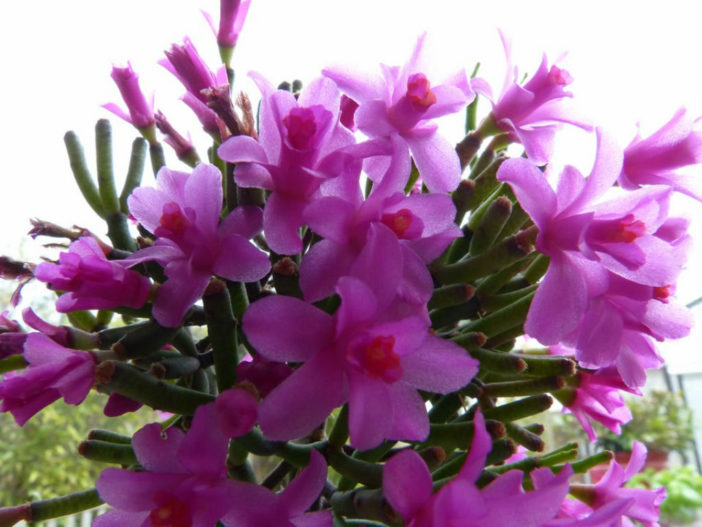Scientific Name
Hatiora herminiae (Porto & A.Cast.) Backeb.ex Barthlott
Synonym(s)
Hariota herminiae, Rhipsalis herminiae
Scientific Classification
Family: Cactaceae
Subfamily: Cactoideae
Tribe: Rhipsalideae
Genus: Hatiora
Description
Hatiora herminiae is a branching cactus with upright or arching stems circular in cross-section and composed of segments. It grows up to 1 foot (30 cm) tall. Stem segments are cylindrical, up to 2 inches (5 cm) long, and up to 0.2 inches (0.5 cm) in diameter, each with a few areoles that bear clusters of grayish hairs. They are grey, dark green, olive green, or with shades of purple in full sun.
The flowers are pink to magenta, up to 0.8 inches (2 cm) long, and up to 1 inch (2.5 cm) in diameter. They appear from the areoles at the ends of stems, usually solitary, in spring. The fruits are up to 0.3 inches (0.8 cm) long, olive green berries.
Origin
Hatiora herminiae is native to southeast Brazil. It grows as an epiphyte in the cloud forests in Minas Gerais and São Paulo.

Hardiness
USDA hardiness zones 10a to 11b: from 30 °F (−1.1 °C) to 50 °F (+10 °C).
How to Grow and Care
Hatiora grows in the wild in tropical rain forests of south-eastern Brazil, as far south as Parana, along the border with Paraguay. Although they grow mostly on tree trunks, they are sometimes found growing on rocky ground. In the wild, Hatiora bloom in spring and will sometimes flower twice in one year.
These cacti thrive best in indirect light with morning and evening sun exposure. They prefer well-drained soil. Cactus or epiphytic compost works well. Hatiora can be propagated easily through cuttings that can root immediately in soil. It likes long nights of about 14 hours. Cover the plant with a paper bag to shut out sunlight. Try not to reposition the plant once flower buds appear, as these could fall off during any movement. It needs a month's rest after flowering, so water sparingly during this period.
Learn more at How to Grow and Care for Hatiora.
Links
- Back to genus Hatiora
- Succupedia: Browse succulents by Scientific Name, Common Name, Genus, Family, USDA Hardiness Zone, Origin, or cacti by Genus
Photo Gallery
Click on a photo to see a larger version.



